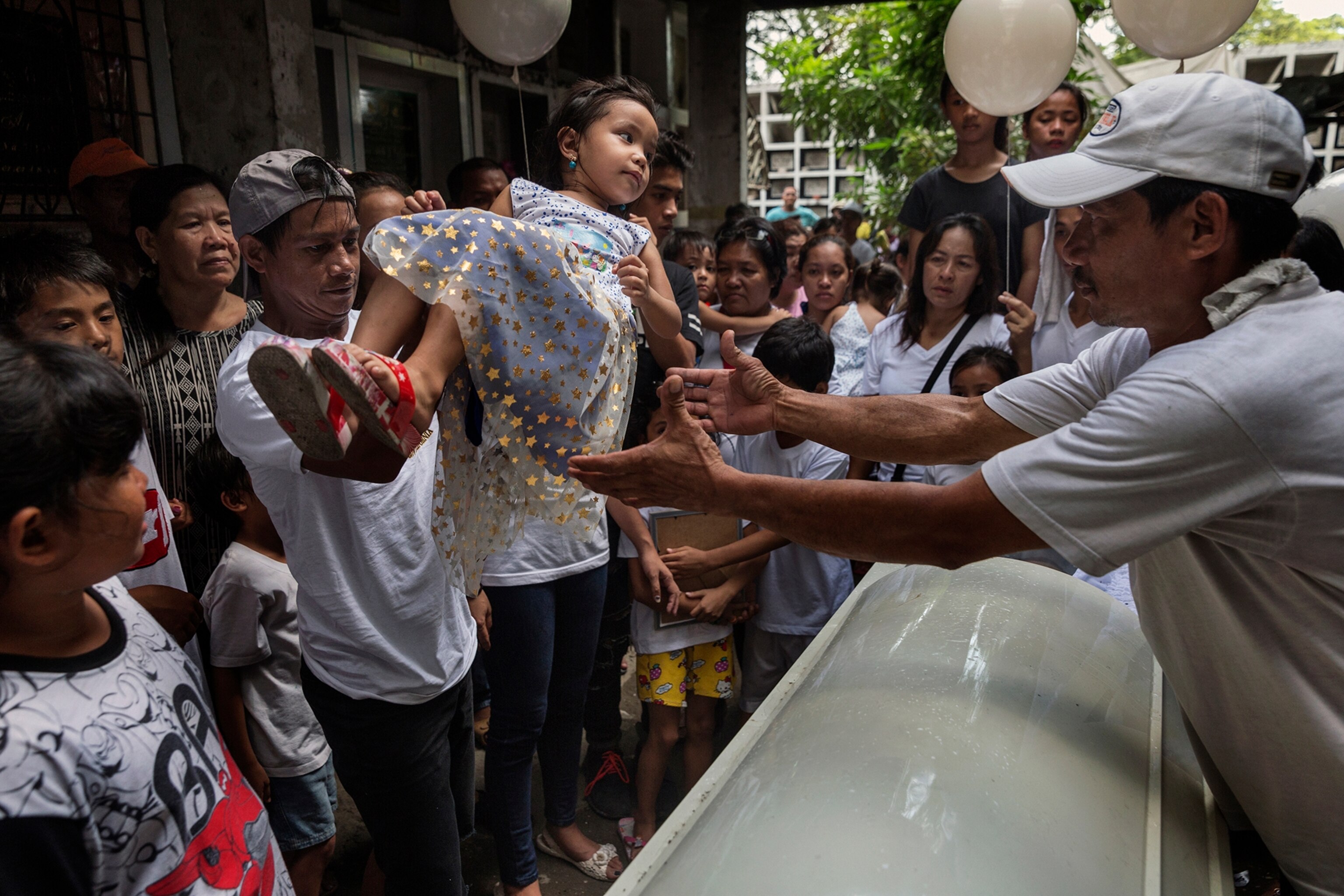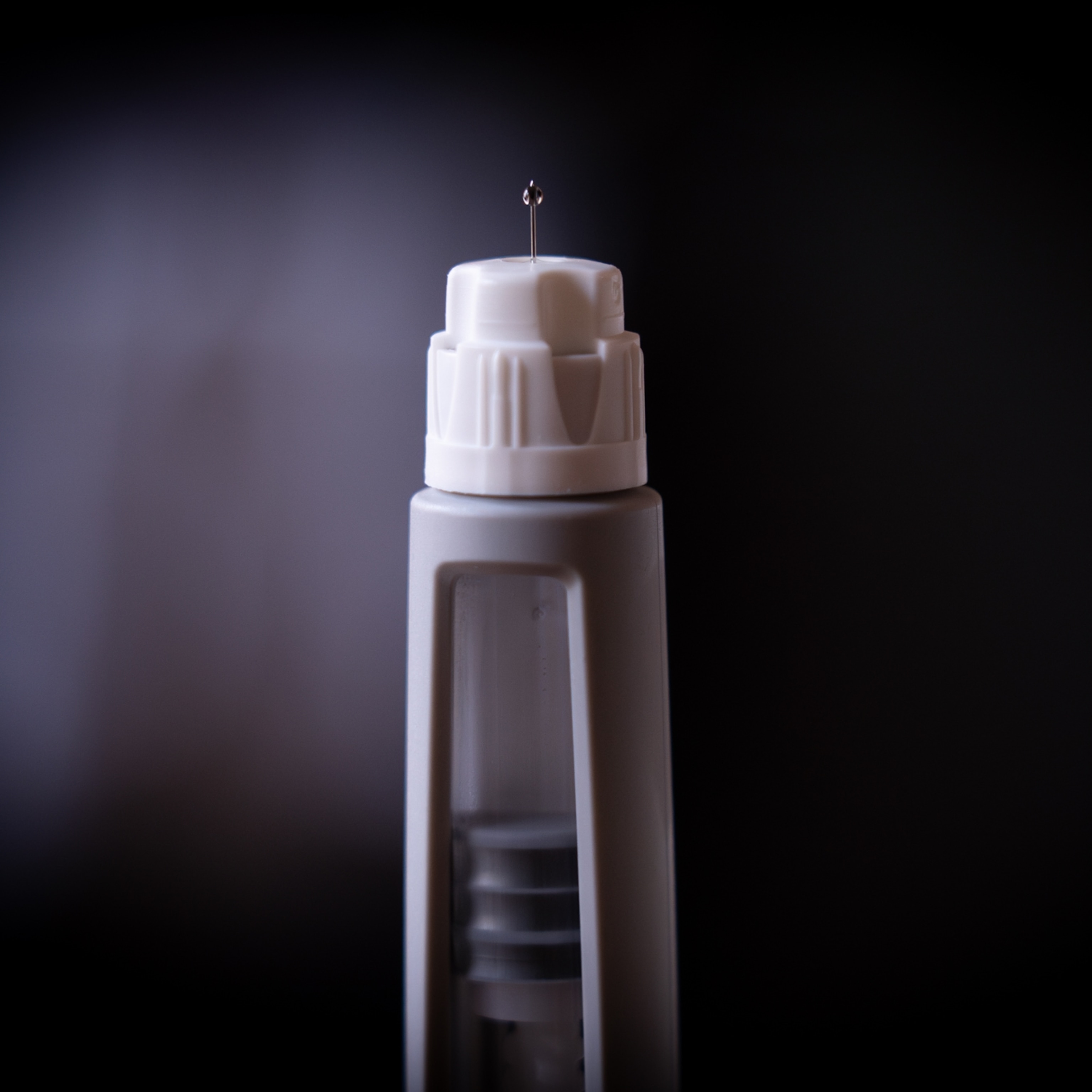
In Philippine Drug War, Death Rituals Substitute for Justice
As a growing number of families are left mourning the victims, ceremonies have become a more common part of life in Manila’s slums.
As soon as Rick Medina saw the body slumped onto the curb on the evening news last November, he knew it was his 24-year-old son, Ericardo. The corpse — dumped on a quiet avenue in the Philippine capital of Manila, with his back to the TV cameras — could have been anyone. But a father knows.
The next morning his daughter Jhoy, 26, went to the morgue. Eight bodies were lined up on the floor, covered in sheets or in body bags. They all died the same way: their heads bound in packing tape, then stabbed multiple times with an ice pick to pierce their lungs. She refused to believe one of them was her brother until she unzipped the final body bag. Jhoy wanted to scream. Instead, she froze.
Ericardo’s body was dumped with a cardboard sign labeling him a drug user. According to his father, Ericardo never touched drugs; Jhoy says he’s dabbled in it. Either way, his killers meted out a final punishment without due process.

The plight of the Medina family has been repeated thousands of times in the Philippines, where Rodrigo Duterte rode a tide of populist frustration to the presidency last year by promising to end drug-related crime within six months. Since his inauguration on June 30, according to police data, at least 2,200 people have been killed by police, and another 4,000 by unknown assailants, perhaps mercenaries. The national murder rate spiked more than 51 percent between July and November. Duterte has extended his bloody anti-drug crusade indefinitely, vowing not to stop “until the last [drug] pusher on the streets is fully exterminated.”
As a growing number of families are left mourning the victims, death rituals are becoming an ever-more common part of life in Manila’s slums, where most of the deaths occur. The rituals are meant to console the family and deepen community ties, but as the death tolls mount, they have come to serve another purpose: They substitute for justice at a time when the killings are committed with staggering impunity.

Steeped in Death Rituals
For hundreds of years, Philippine culture has been steeped in death rituals, which outnumber ceremonies performed for births or marriages, says anthropologist Nestor Castro of the University of the Philippines, Diliman. They’re vestiges of pre-Hispanic Philippine culture combined with Catholicism spread by Spanish colonialists some 500 years ago.
Filipinos perform any number of rituals around death. A pot is thrown on the ground to break the cycle of death, and prevent more from following. The dead person’s favorite personal items — perhaps a snapback cap or pack of cigarettes — are tucked into the casket so he or she can have them in the afterlife. When it leaves the home, the casket is spun three times to confuse the spirit and stop him from returning. Coins are thrown along the path of the funeral procession to help pay for travels to the next life. Children are carried over the casket before burial to keep the ghost from haunting the living. Three days after a death, the spirit is supposed to visit a member of the family. The visit, called pakiramdam, lets the family know the state of the spirit, and takes on particular urgency when the death is sudden and violent.












A Family’s Grief
Rick Medina lives in a shack propped up among the tombs of the Pasay public cemetery. His daughter lives a few feet away over a stack of crypts. They make a modest living keeping graves clean and selling snacks to people visiting the dead. Most nights Ericardo slept sprawled out on a tomb under a coconut tree outside Jhoy’s home.
Before her brother died, Jhoy watched as a row of tombs filled up with the victims of the anti-drug campaign. “I saw the people crying, saying there was no justice,” she said. “I didn’t realize we would know that feeling, too.”
The day after Ericardo’s death, Rick, who is frail and still struggles to talk about what happened to his son, took a copy of his death certificate and stood at a busy avenue begging passing motorists for money. From the other cemetery-dwellers, Jhoy heard of a recent cremation, and she got permission to reuse the casket. They dressed Ericardo in a traditional Filipino garment, wrapped a rosary in his hands, and laid him out for the seven-day wake of Filipino folk Catholicism. Day and night Jhoy and their other siblings didn’t leave his side. Friends and family came to whisper their final goodbyes to Ericardo’s embalmed remains.
During his wake, Jhoy waited for the feeling that Ericardo’s ghost was with them. She posted on Facebook asking if anyone had had contact with Ericardo. No one had. “I was so annoyed with him,” she said, “it had been six days and he still hadn’t made himself felt.”
It wasn’t until the day before his funeral that she felt him at the convenience store near the intersection where he worked, the last place he was seen alive, climbing onto the back of someone’s motorcycle. That night, Ericardo visited Jhoy in a dream.
“He was smiling,” she said. When she consulted the local spiritista, an old woman who communes with the dead, the woman told her that Ericardo did not want the family to suffer, he wanted them to feel that he was still alive. It gave her comfort to know that Ericardo was not an angry spirit, lingering in this world, unable to accept his own death and demanding vengeance. “It was just like him,” Jhoy said, “He was always so easy-going.”
Still there’s one more dream Jhoy craves. “I want to dream about the night he was killed,” she said. “I want to stab the person who stabbed him. So I can finally defend him,” even if just in her dreams.


War on Drugs
A dream of vengeance may be the nearest thing to justice Jhoy and others can hope for. Few of the killers are ever caught.
Many of the people in slum areas heavily targeted by unknown assailants suspect that the police are involved and turn a blind eye to the killings. Investigations into individual murders are cursory, with the police collecting little more than the basic facts before the cases go cold. There are no visible efforts by the police to stop motorcycle-riding gunmen from sweeping through a neighborhood. In Manila, killings in one night regularly reach the double digits.
In remarks during the Philippine National Police Christmas party, Police Chief Ronald dela Rosa, accepts the police’s role in initiating the rising death toll, but denies police involvement in the thousands of murders committed by unknown assailants. Instead, he says vigilantes may be responsible.
“Indeed there have been killings, so forgive us,” dela Rosa said, in a mixture of Filipino and English. “We’re not saying we’re behind the [extrajudicial killings] you’re talking about. Many have joined the bandwagon of the war on drugs, but still they become victims because of our war on drugs. The blame is still on us because we initiated this war on drugs."
Dela Rosa, however, continued to defend the more than 2000 people who have been killed in police anti-drug operations. Police claim the suspects were killed in self-defense, an assertion witnesses regularly dispute. For his part, Duterte has encouraged the police force to act aggressively. He promised to pardon policemen convicted of killing suspects while carrying out his anti-drug campaign, a statement human rights advocates argue encourages impunity in the police force. Duterte underscored his position when the Philippine National Bureau of Investigation accused policemen of killing a drug suspect as he lay defenseless inside a jail cell. "I will not allow these guys to go to prison, even if the NBI says it was murder," Duterte said in December. "Whatever the police say, that's the truth for me."


A Child’s Death
Not far from Pasay cemetery, five-year-old Francis Mañosca lay in a white casket. A pair of chicks clucked on the Plexiglas fitted over his embalmed corpse. Chicks are an old Filipino tradition, meant to peck away at the conscience of his murderer, who shot Francis between the eyes as he slept. The intended target, his father, Domingo, 44, was also killed. His mother Elizabeth Navarro, 29, sat silently crumpled on the floor between their two caskets, nine months pregnant and cradling her toddler.
Maila Tumazaro, Domingo Mañosca’s sister-in-law, hopes that guilt will keep Francis’s killer up at night, but when asked if the family planned to pursue a case, she was resigned. “There’s no one for us to file a case against,” she said.
The boy’s death did not garner a public outcry; it received fleeting local media coverage. A recent survey found that while 94 percent of Filipinos disagree with the killings and believe drug suspects should remain alive, support for Duterte remains high, with 77 percent of Filipinos saying they were satisfied with his job performance.
The killings are focused in poor neighborhoods, among people who have the least clout.


In Caloocan, another slum district in northern Manila, the family of 35-year-old Rommel Silva Aquino brought his casket to Manila North Cemetery. Aquino was killed in a police operation twenty days earlier. The family dragged out the wake in order to gather the money to pay for his funeral. They raised 30,000 pesos, or about $600, by keeping part of the profits of gambling card games at his wake. By the time they buried him, his body had already begun to decompose, his left eye socket was stuffed with cotton to keep the rot from spreading. Still the money fell short. After an extended negotiation at the graveside, the gravediggers agreed to seal the crypt and attach the tombstone for free.
“We’ve buried so many people who are victims of Tokhang,” Barok Manahan, the gravedigger said, referring to the police’s most high-profile operation for the anti-drug campaign. “They have absolutely no money.”
In Navotas, a slum district around Manila’s port, the family of Joaquin Garbo, killed in an alleged case of mistaken identity, wept as they prepared to bury him. The children circled the casket. Coins were thrown to ease his path to the afterlife. However, less than a kilometer from Garbo’s wake, was a harsh reminder that the rituals bring more comfort than action: Another man splayed out on the asphalt in a pool of blood, the milling policemen casting long shadows in the morning light.

Back at the Pasay cemetery, Jhoy Medina whispers a greeting and presses her hand against the still-fresh cement of her brother’s grave.
“If all the families who have suffered a death speak out about everything that they’ve felt,” she said, “maybe it will reach Duterte.” She hopes that if he understands their pain, he might stop the killings. But in her heart she believes that the killings won’t stop until Duterte is no longer president.
On January 30, 2017, following a series of corruption scandals involving the police — the most egregious being the murder of a Korean businessman by policemen in national police headquarters under the guise of an anti-drug operation — General dela Rosa ordered the suspension of all anti-drug operations while the police go through what he called an “internal cleansing.”
While this is an admission of police wrongdoing, Duterte indicated that this will likely be a short reprieve. The same day, he reiterated his vow that the drug war would continue until his last day in office.

Related Topics
You May Also Like
Go Further
Animals
- Soy, skim … spider. Are any of these technically milk?Soy, skim … spider. Are any of these technically milk?
- This pristine piece of the Amazon shows nature’s resilienceThis pristine piece of the Amazon shows nature’s resilience
- Octopuses have a lot of secrets. Can you guess 8 of them?
- Animals
- Feature
Octopuses have a lot of secrets. Can you guess 8 of them? - This biologist and her rescue dog help protect bears in the AndesThis biologist and her rescue dog help protect bears in the Andes
Environment
- This pristine piece of the Amazon shows nature’s resilienceThis pristine piece of the Amazon shows nature’s resilience
- Listen to 30 years of climate change transformed into haunting musicListen to 30 years of climate change transformed into haunting music
- This ancient society tried to stop El Niño—with child sacrificeThis ancient society tried to stop El Niño—with child sacrifice
- U.S. plans to clean its drinking water. What does that mean?U.S. plans to clean its drinking water. What does that mean?
- Food systems: supporting the triangle of food security, Video Story
- Paid Content
Food systems: supporting the triangle of food security
History & Culture
- Heard of Zoroastrianism? The religion still has fervent followersHeard of Zoroastrianism? The religion still has fervent followers
- Strange clues in a Maya temple reveal a fiery political dramaStrange clues in a Maya temple reveal a fiery political drama
- How technology is revealing secrets in these ancient scrollsHow technology is revealing secrets in these ancient scrolls
- Pilgrimages aren’t just spiritual anymore. They’re a workout.Pilgrimages aren’t just spiritual anymore. They’re a workout.
- This ancient society tried to stop El Niño—with child sacrificeThis ancient society tried to stop El Niño—with child sacrifice
Science
- Soy, skim … spider. Are any of these technically milk?Soy, skim … spider. Are any of these technically milk?
- Can aspirin help protect against colorectal cancers?Can aspirin help protect against colorectal cancers?
- The unexpected health benefits of Ozempic and MounjaroThe unexpected health benefits of Ozempic and Mounjaro
- Do you have an inner monologue? Here’s what it reveals about you.Do you have an inner monologue? Here’s what it reveals about you.
- Jupiter’s volcanic moon Io has been erupting for billions of yearsJupiter’s volcanic moon Io has been erupting for billions of years
Travel
- This chef is taking Indian cuisine in a bold new directionThis chef is taking Indian cuisine in a bold new direction
- On the path of Latin America's greatest wildlife migrationOn the path of Latin America's greatest wildlife migration
- Everything you need to know about Everglades National ParkEverything you need to know about Everglades National Park
- Spend a night at the museum at these 7 spots around the worldSpend a night at the museum at these 7 spots around the world







